github.com/yacovm/fabric@v2.0.0-alpha.0.20191128145320-c5d4087dc723+incompatible/docs/source/network/network.md (about) 1 # Blockchain network 2 3 This topic will describe, **at a conceptual level**, how Hyperledger Fabric 4 allows organizations to collaborate in the formation of blockchain networks. If 5 you're an architect, administrator or developer, you can use this topic to get a 6 solid understanding of the major structure and process components in a 7 Hyperledger Fabric blockchain network. This topic will use a manageable worked 8 example that introduces all of the major components in a blockchain network. 9 After understanding this example you can read more detailed information about 10 these components elsewhere in the documentation, or try 11 [building a sample network](../build_network.html). 12 13 After reading this topic and understanding the concept of policies, you will 14 have a solid understanding of the decisions that organizations need to make to 15 establish the policies that control a deployed Hyperledger Fabric network. 16 You'll also understand how organizations manage network evolution using 17 declarative policies -- a key feature of Hyperledger Fabric. In a nutshell, 18 you'll understand the major technical components of Hyperledger Fabric and the 19 decisions organizations need to make about them. 20 21 ## What is a blockchain network? 22 23 A blockchain network is a technical infrastructure that provides ledger and 24 smart contract (chaincode) services to applications. Primarily, smart contracts 25 are used to generate transactions which are subsequently distributed to every 26 peer node in the network where they are immutably recorded on their copy of the 27 ledger. The users of applications might be end users using client applications 28 or blockchain network administrators. 29 30 In most cases, multiple [organizations](../glossary.html#organization) come 31 together as a [consortium](../glossary.html#consortium) to form the network and 32 their permissions are determined by a set of [policies](../glossary.html#policy) 33 that are agreed by the consortium when the network is originally configured. 34 Moreover, network policies can change over time subject to the agreement of the 35 organizations in the consortium, as we'll discover when we discuss the concept 36 of *modification policy*. 37 38 ## The sample network 39 40 Before we start, let's show you what we're aiming at! Here's a diagram 41 representing the **final state** of our sample network. 42 43 Don't worry that this might look complicated! As we go through this topic, we 44 will build up the network piece by piece, so that you see how the organizations 45 R1, R2, R3 and R4 contribute infrastructure to the network to help form it. This 46 infrastructure implements the blockchain network, and it is governed by policies 47 agreed by the organizations who form the network -- for example, who can add new 48 organizations. You'll discover how applications consume the ledger and smart 49 contract services provided by the blockchain network. 50 51 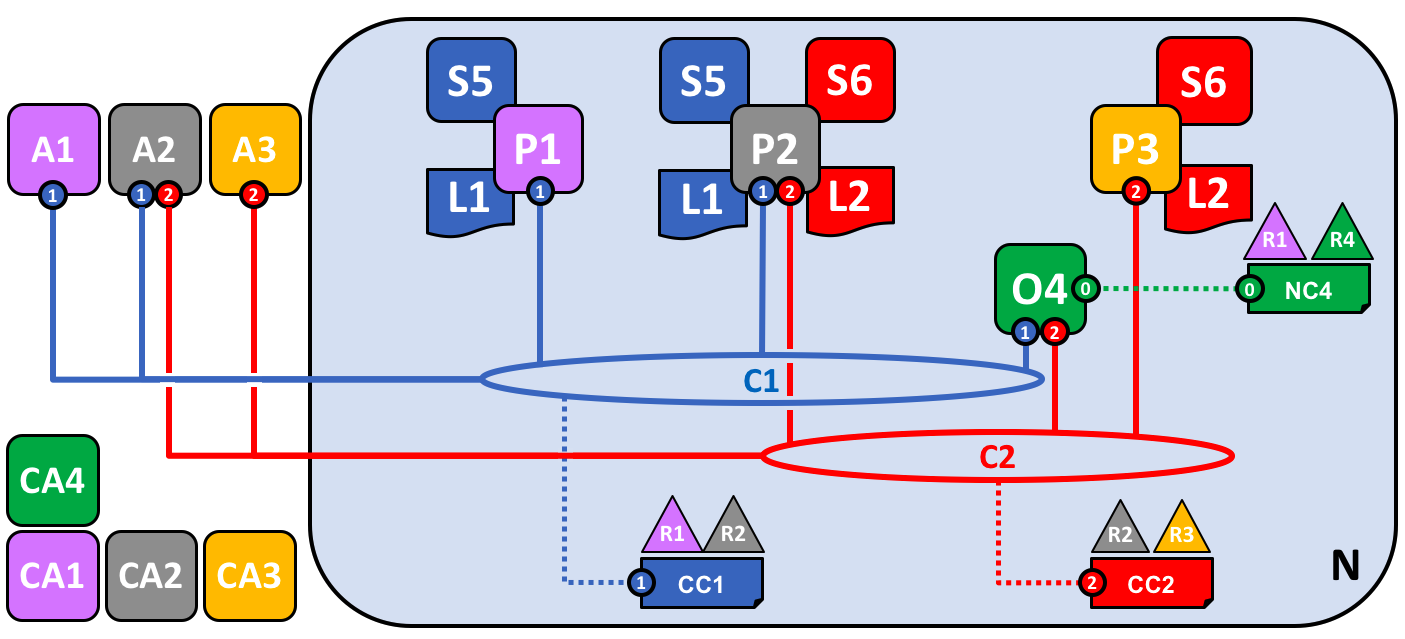 52 53 *Four organizations, R1, R2, R3 and R4 have jointly decided, and written into an 54 agreement, that they will set up and exploit a Hyperledger Fabric 55 network. R4 has been assigned to be the network initiator -- it has been given 56 the power to set up the initial version of the network. R4 has no intention to 57 perform business transactions on the network. R1 and R2 have a need for a 58 private communications within the overall network, as do R2 and R3. 59 Organization R1 has a client application that can perform business transactions 60 within channel C1. Organization R2 has a client application that can do similar 61 work both in channel C1 and C2. Organization R3 has a client application that 62 can do this on channel C2. Peer node P1 maintains a copy of the ledger L1 63 associated with C1. Peer node P2 maintains a copy of the ledger L1 associated 64 with C1 and a copy of ledger L2 associated with C2. Peer node P3 maintains a 65 copy of the ledger L2 associated with C2. The network is governed according to 66 policy rules specified in network configuration NC4, the network is under the 67 control of organizations R1 and R4. Channel C1 is governed according to the 68 policy rules specified in channel configuration CC1; the channel is under the 69 control of organizations R1 and R2. Channel C2 is governed according to the 70 policy rules specified in channel configuration CC2; the channel is under the 71 control of organizations R2 and R3. There is an ordering service O4 that 72 services as a network administration point for N, and uses the system channel. 73 The ordering service also supports application channels C1 and C2, for the 74 purposes of transaction ordering into blocks for distribution. Each of the four 75 organizations has a preferred Certificate Authority.* 76 77 ## Creating the Network 78 79 Let's start at the beginning by creating the basis for the network: 80 81 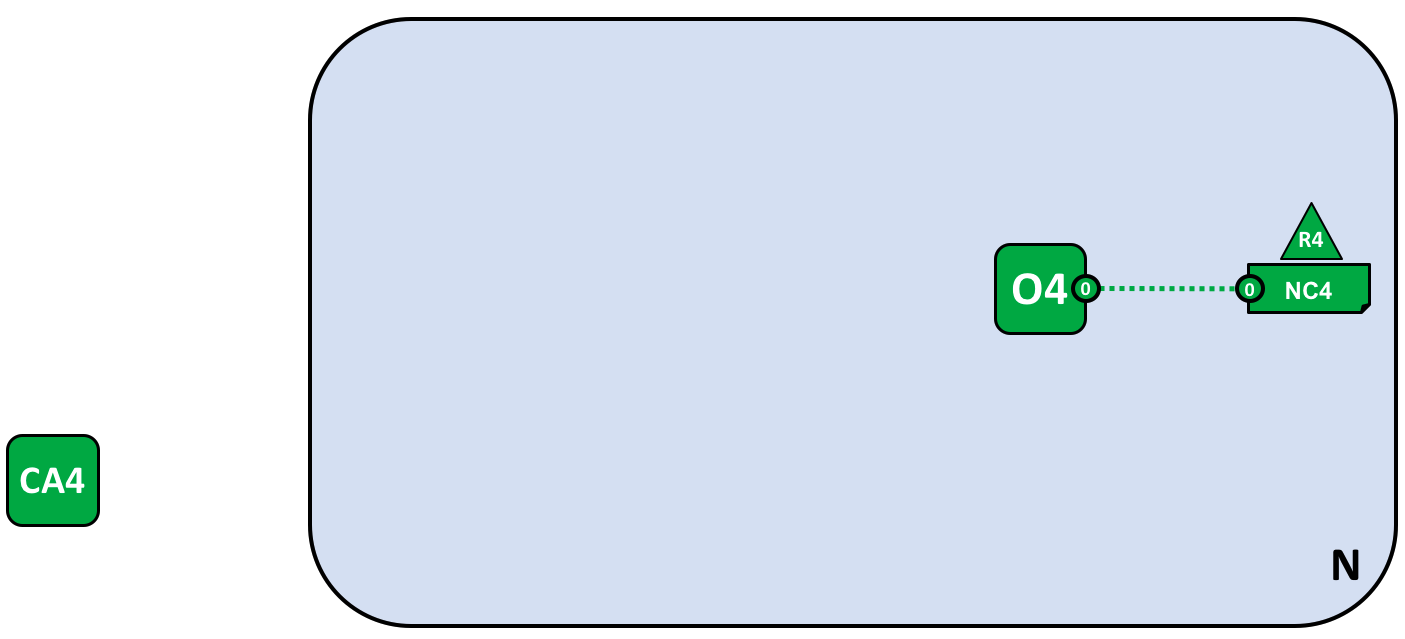 82 83 *The network is formed when an orderer is started. In our example network, N, 84 the ordering service comprising a single node, O4, is configured according to a 85 network configuration NC4, which gives administrative rights to organization 86 R4. At the network level, Certificate Authority CA4 is used to dispense 87 identities to the administrators and network nodes of the R4 organization.* 88 89 We can see that the first thing that defines a **network, N,** is an **ordering 90 service, O4**. It's helpful to think of the ordering service as the initial 91 administration point for the network. As agreed beforehand, O4 is initially 92 configured and started by an administrator in organization R4, and hosted in R4. 93 The configuration NC4 contains the policies that describe the starting set of 94 administrative capabilities for the network. Initially this is set to only give 95 R4 rights over the network. This will change, as we'll see later, but for now R4 96 is the only member of the network. 97 98 ### Certificate Authorities 99 100 You can also see a Certificate Authority, CA4, which is used to issue 101 certificates to administrators and network nodes. CA4 plays a key role in our 102 network because it dispenses X.509 certificates that can be used to identify 103 components as belonging to organization R4. Certificates issued by CAs 104 can also be used to sign transactions to indicate that an organization endorses 105 the transaction result -- a precondition of it being accepted onto the 106 ledger. Let's examine these two aspects of a CA in a little more detail. 107 108 Firstly, different components of the blockchain network use certificates to 109 identify themselves to each other as being from a particular organization. 110 That's why there is usually more than one CA supporting a blockchain network -- 111 different organizations often use different CAs. We're going to use four CAs in 112 our network; one for each organization. Indeed, CAs are so important that 113 Hyperledger Fabric provides you with a built-in one (called *Fabric-CA*) to help 114 you get going, though in practice, organizations will choose to use their own 115 CA. 116 117 The mapping of certificates to member organizations is achieved by via 118 a structure called a 119 [Membership Services Provider (MSP)](../glossary.html#membership-services). 120 Network configuration NC4 uses a named 121 MSP to identify the properties of certificates dispensed by CA4 which associate 122 certificate holders with organization R4. NC4 can then use this MSP name in 123 policies to grant actors from R4 particular 124 rights over network resources. An example of such a policy is to identify the 125 administrators in R4 who can add new member organizations to the network. We 126 don't show MSPs on these diagrams, as they would just clutter them up, but they 127 are very important. 128 129 Secondly, we'll see later how certificates issued by CAs are at the heart of the 130 [transaction](../glossary.html#transaction) generation and validation process. 131 Specifically, X.509 certificates are used in client application 132 [transaction proposals](../glossary.html#proposal) and smart contract 133 [transaction responses](../glossary.html#response) to digitally sign 134 [transactions](../glossary.html#transaction). Subsequently the network nodes 135 who host copies of the ledger verify that transaction signatures are valid 136 before accepting transactions onto the ledger. 137 138 Let's recap the basic structure of our example blockchain network. There's a 139 resource, the network N, accessed by a set of users defined by a Certificate 140 Authority CA4, who have a set of rights over the resources in the network N as 141 described by policies contained inside a network configuration NC4. All of this 142 is made real when we configure and start the ordering service node O4. 143 144 ## Adding Network Administrators 145 146 NC4 was initially configured to only allow R4 users administrative rights over 147 the network. In this next phase, we are going to allow organization R1 users to 148 administer the network. Let's see how the network evolves: 149 150 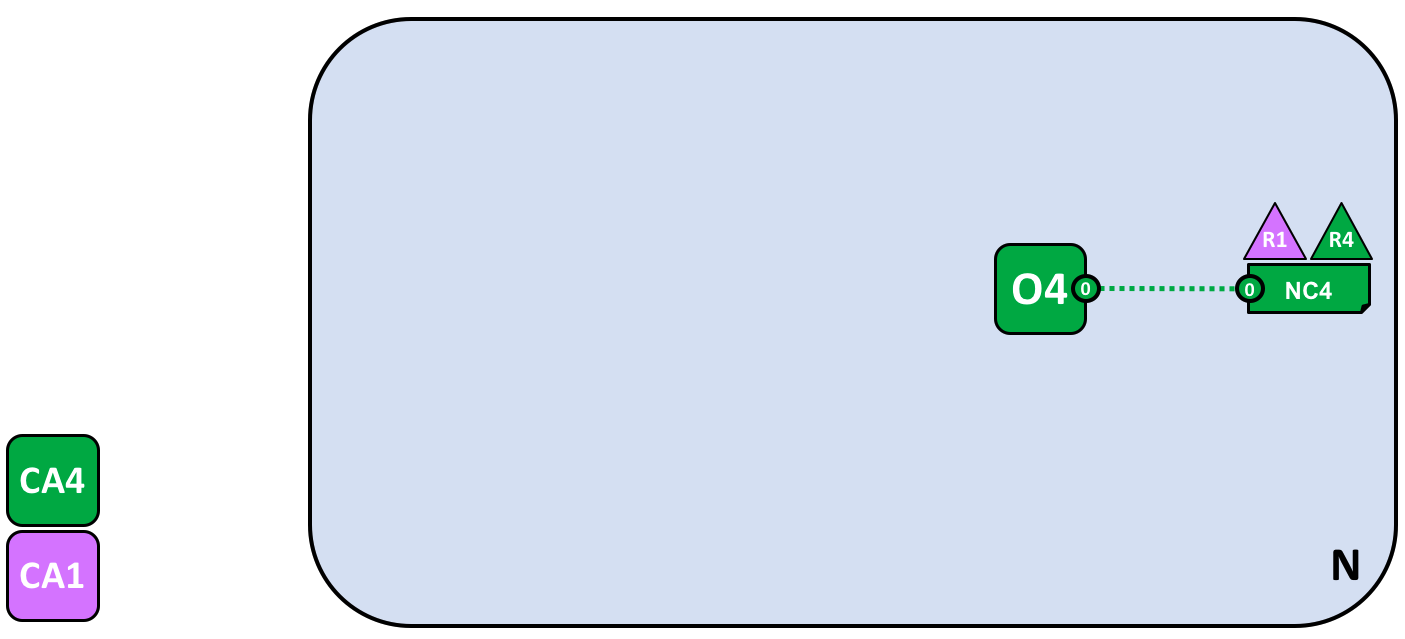 151 152 *Organization R4 updates the network configuration to make organization R1 an 153 administrator too. After this point R1 and R4 have equal rights over the 154 network configuration.* 155 156 We see the addition of a new organization R1 as an administrator -- R1 and R4 157 now have equal rights over the network. We can also see that certificate 158 authority CA1 has been added -- it can be used to identify users from the R1 159 organization. After this point, users from both R1 and R4 can administer the 160 network. 161 162 Although the orderer node, O4, is running on R4's infrastructure, R1 has shared 163 administrative rights over it, as long as it can gain network access. It means 164 that R1 or R4 could update the network configuration NC4 to allow the R2 165 organization a subset of network operations. In this way, even though R4 is 166 running the ordering service, and R1 has full administrative rights over it, R2 167 has limited rights to create new consortia. 168 169 In its simplest form, the ordering service is a single node in the network, and 170 that's what you can see in the example. Ordering services are usually 171 multi-node, and can be configured to have different nodes in different 172 organizations. For example, we might run O4 in R4 and connect it to O2, a 173 separate orderer node in organization R1. In this way, we would have a 174 multi-site, multi-organization administration structure. 175 176 We'll discuss the ordering service a little [later in this topic](#the-ordering-service), 177 but for now just think of the ordering service as an administration point which 178 provides different organizations controlled access to the network. 179 180 ## Defining a Consortium 181 182 Although the network can now be administered by R1 and R4, there is very little 183 that can be done. The first thing we need to do is define a consortium. This 184 word literally means "a group with a shared destiny", so it's an appropriate 185 choice for a set of organizations in a blockchain network. 186 187 Let's see how a consortium is defined: 188 189 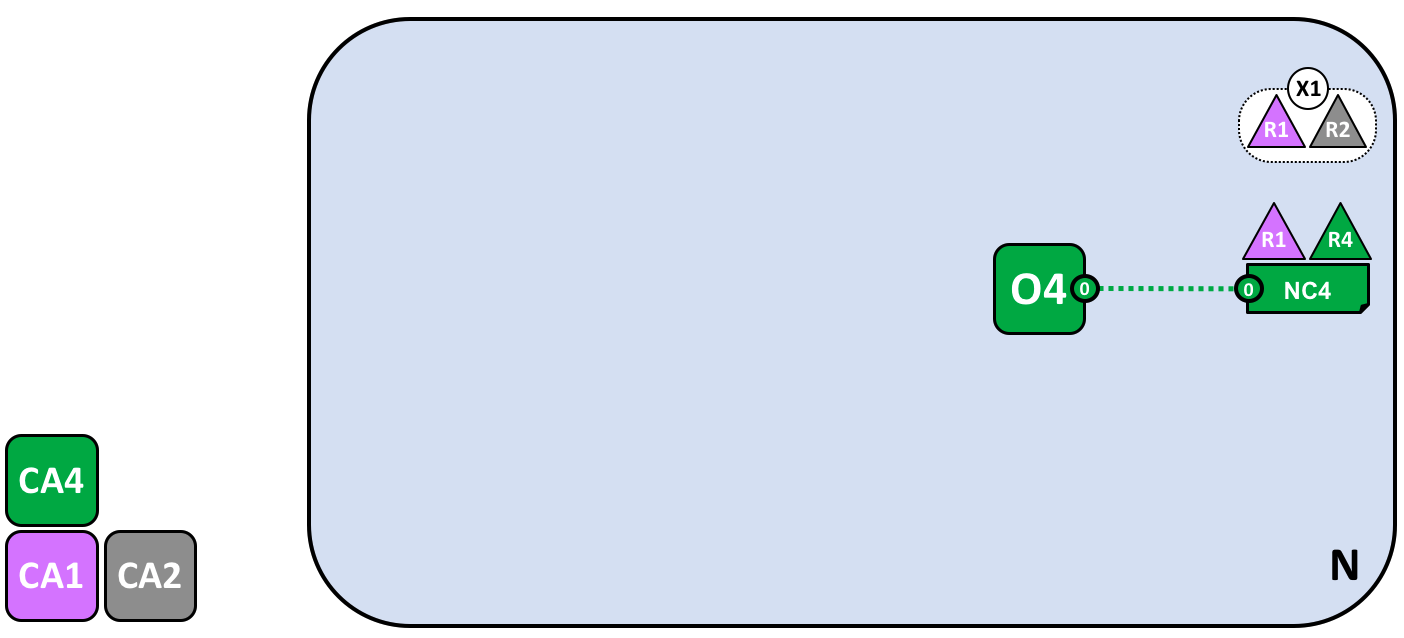 190 191 *A network administrator defines a consortium X1 that contains two members, 192 the organizations R1 and R2. This consortium definition is stored in the 193 network configuration NC4, and will be used at the next stage of network 194 development. CA1 and CA2 are the respective Certificate Authorities for these 195 organizations.* 196 197 Because of the way NC4 is configured, only R1 or R4 can create new consortia. 198 This diagram shows the addition of a new consortium, X1, which defines R1 and R2 199 as its constituting organizations. We can also see that CA2 has been added to 200 identify users from R2. Note that a consortium can have any number of 201 organizational members -- we have just shown two as it is the simplest 202 configuration. 203 204 Why are consortia important? We can see that a consortium defines the set of 205 organizations in the network who share a need to **transact** with one another -- 206 in this case R1 and R2. It really makes sense to group organizations together if 207 they have a common goal, and that's exactly what's happening. 208 209 The network, although started by a single organization, is now controlled by a 210 larger set of organizations. We could have started it this way, with R1, R2 and 211 R4 having shared control, but this build up makes it easier to understand. 212 213 We're now going to use consortium X1 to create a really important part of a 214 Hyperledger Fabric blockchain -- **a channel**. 215 216 ## Creating a channel for a consortium 217 218 So let's create this key part of the Fabric blockchain network -- **a channel**. 219 A channel is a primary communications mechanism by which the members of a 220 consortium can communicate with each other. There can be multiple channels in a 221 network, but for now, we'll start with one. 222 223 Let's see how the first channel has been added to the network: 224 225 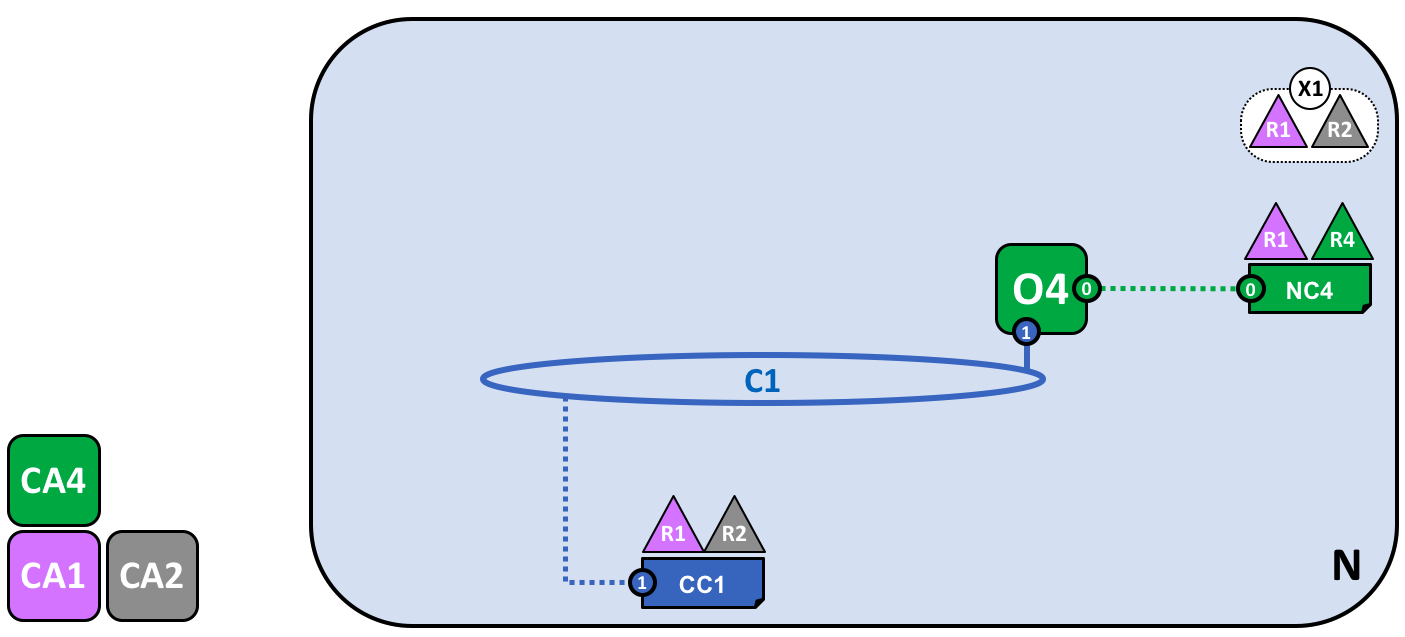 226 227 *A channel C1 has been created for R1 and R2 using the consortium definition X1. 228 The channel is governed by a channel configuration CC1, completely separate to 229 the network configuration. CC1 is managed by R1 and R2 who have equal rights 230 over C1. R4 has no rights in CC1 whatsoever.* 231 232 The channel C1 provides a private communications mechanism for the consortium 233 X1. We can see channel C1 has been connected to the ordering service O4 but that 234 nothing else is attached to it. In the next stage of network development, we're 235 going to connect components such as client applications and peer nodes. But at 236 this point, a channel represents the **potential** for future connectivity. 237 238 Even though channel C1 is a part of the network N, it is quite distinguishable 239 from it. Also notice that organizations R3 and R4 are not in this channel -- it 240 is for transaction processing between R1 and R2. In the previous step, we saw 241 how R4 could grant R1 permission to create new consortia. It's helpful to 242 mention that R4 **also** allowed R1 to create channels! In this diagram, it 243 could have been organization R1 or R4 who created a channel C1. Again, note 244 that a channel can have any number of organizations connected to it -- we've 245 shown two as it's the simplest configuration. 246 247 Again, notice how channel C1 has a completely separate configuration, CC1, to 248 the network configuration NC4. CC1 contains the policies that govern the 249 rights that R1 and R2 have over the channel C1 -- and as we've seen, R3 and 250 R4 have no permissions in this channel. R3 and R4 can only interact with C1 if 251 they are added by R1 or R2 to the appropriate policy in the channel 252 configuration CC1. An example is defining who can add a new organization to the 253 channel. Specifically, note that R4 cannot add itself to the channel C1 -- it 254 must, and can only, be authorized by R1 or R2. 255 256 Why are channels so important? Channels are useful because they provide a 257 mechanism for private communications and private data between the members of a 258 consortium. Channels provide privacy from other channels, and from the network. 259 Hyperledger Fabric is powerful in this regard, as it allows organizations to 260 share infrastructure and keep it private at the same time. There's no 261 contradiction here -- different consortia within the network will have a need 262 for different information and processes to be appropriately shared, and channels 263 provide an efficient mechanism to do this. Channels provide an efficient 264 sharing of infrastructure while maintaining data and communications privacy. 265 266 We can also see that once a channel has been created, it is in a very real sense 267 "free from the network". It is only organizations that are explicitly specified 268 in a channel configuration that have any control over it, from this time forward 269 into the future. Likewise, any updates to network configuration NC4 from this 270 time onwards will have no direct effect on channel configuration CC1; for 271 example if consortia definition X1 is changed, it will not affect the members of 272 channel C1. Channels are therefore useful because they allow private 273 communications between the organizations constituting the channel. Moreover, the 274 data in a channel is completely isolated from the rest of the network, including 275 other channels. 276 277 As an aside, there is also a special **system channel** defined for use by the 278 ordering service. It behaves in exactly the same way as a regular channel, 279 which are sometimes called **application channels** for this reason. We don't 280 normally need to worry about this channel, but we'll discuss a little bit more 281 about it [later in this topic](#the-ordering-service). 282 283 ## Peers and Ledgers 284 285 Let's now start to use the channel to connect the blockchain network and the 286 organizational components together. In the next stage of network development, we 287 can see that our network N has just acquired two new components, namely a peer 288 node P1 and a ledger instance, L1. 289 290 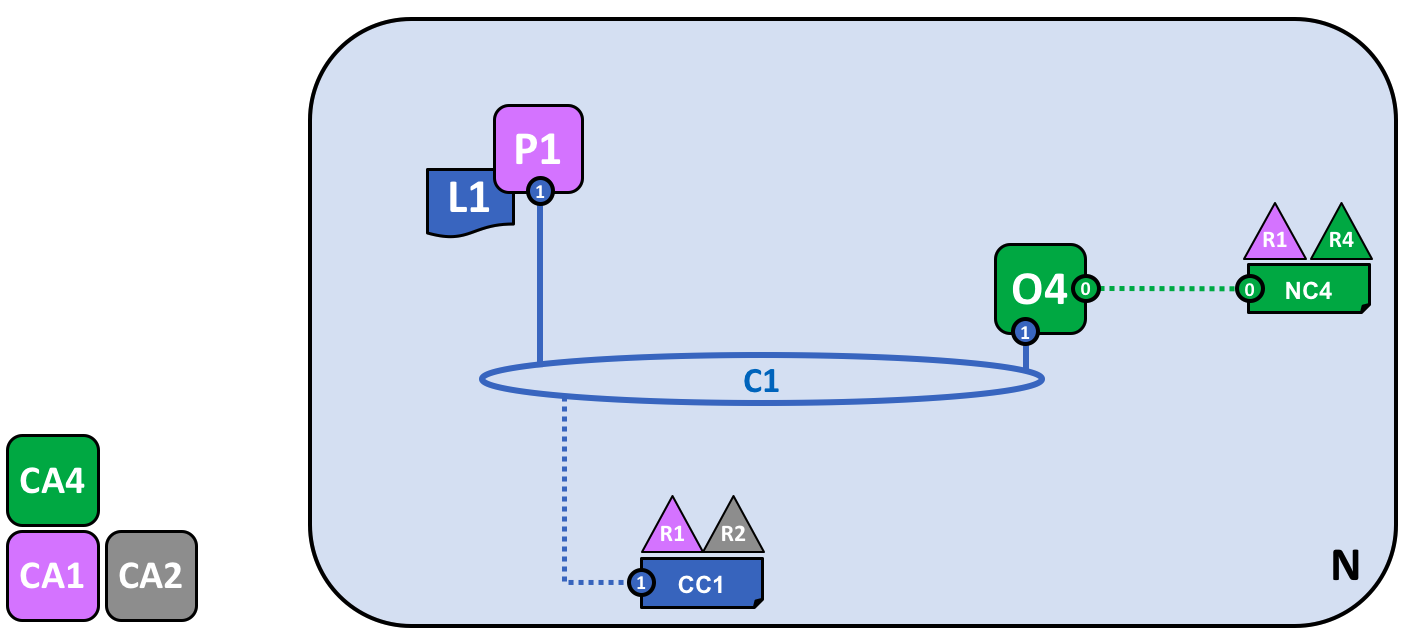 291 292 *A peer node P1 has joined the channel C1. P1 physically hosts a copy of the 293 ledger L1. P1 and O4 can communicate with each other using channel C1.* 294 295 Peer nodes are the network components where copies of the blockchain ledger are 296 hosted! At last, we're starting to see some recognizable blockchain components! 297 P1's purpose in the network is purely to host a copy of the ledger L1 for others 298 to access. We can think of L1 as being **physically hosted** on P1, but 299 **logically hosted** on the channel C1. We'll see this idea more clearly when we 300 add more peers to the channel. 301 302 A key part of a P1's configuration is an X.509 identity issued by CA1 which 303 associates P1 with organization R1. Once P1 is started, it can **join** channel 304 C1 using the orderer O4. When O4 receives this join request, it uses the channel 305 configuration CC1 to determine P1's permissions on this channel. For example, 306 CC1 determines whether P1 can read and/or write information to the ledger L1. 307 308 Notice how peers are joined to channels by the organizations that own them, and 309 though we've only added one peer, we'll see how there can be multiple peer 310 nodes on multiple channels within the network. We'll see the different roles 311 that peers can take on a little later. 312 313 ## Applications and Smart Contract chaincode 314 315 Now that the channel C1 has a ledger on it, we can start connecting client 316 applications to consume some of the services provided by workhorse of the 317 ledger, the peer! 318 319 Notice how the network has grown: 320 321  322 323 *A smart contract S5 has been installed onto P1. Client application A1 in 324 organization R1 can use S5 to access the ledger via peer node P1. A1, P1 and 325 O4 are all joined to channel C1, i.e. they can all make use of the 326 communication facilities provided by that channel.* 327 328 In the next stage of network development, we can see that client application A1 329 can use channel C1 to connect to specific network resources -- in this case A1 330 can connect to both peer node P1 and orderer node O4. Again, see how channels 331 are central to the communication between network and organization components. 332 Just like peers and orderers, a client application will have an identity that 333 associates it with an organization. In our example, client application A1 is 334 associated with organization R1; and although it is outside the Fabric 335 blockchain network, it is connected to it via the channel C1. 336 337 It might now appear that A1 can access the ledger L1 directly via P1, but in 338 fact, all access is managed via a special program called a smart contract 339 chaincode, S5. Think of S5 as defining all the common access patterns to the 340 ledger; S5 provides a well-defined set of ways by which the ledger L1 can 341 be queried or updated. In short, client application A1 has to go through smart 342 contract S5 to get to ledger L1! 343 344 Smart contracts can be created by application developers in each organization to 345 implement a business process shared by the consortium members. Smart contracts 346 are used to help generate transactions which can be subsequently distributed to 347 every node in the network. We'll discuss this idea a little later; it'll be 348 easier to understand when the network is bigger. For now, the important thing to 349 understand is that to get to this point two operations must have been performed 350 on the smart contract; it must have been **installed** on peers, and then 351 **defined** on a channel. 352 353 Hyperledger Fabric users often use the terms **smart contract** and 354 **chaincode** interchangeably. In general, a smart contract defines the 355 **transaction logic** that controls the lifecycle of a business object contained 356 in the world state. It is then packaged into a chaincode which is then deployed 357 to a blockchain network. Think of smart contracts as governing transactions, 358 whereas chaincode governs how smart contracts are packaged for deployment. 359 360 ### Installing a chaincode package 361 362 After a smart contract S5 has been developed, an administrator in organization 363 R1 must create a chaincode package and [install](../glossary.html#install) it 364 onto peer node P1. This is a straightforward operation; once completed, P1 has 365 full knowledge of S5. Specifically, P1 can see the **implementation** logic of 366 S5 -- the program code that it uses to access the ledger L1. We contrast this to 367 the S5 **interface** which merely describes the inputs and outputs of S5, 368 without regard to its implementation. 369 370 When an organization has multiple peers in a channel, it can choose the peers 371 upon which it installs smart contracts; it does not need to install a smart 372 contract on every peer. 373 374 ### Defining a chaincode 375 376 Although a chaincode is installed on the peers of individual organizations, it 377 is governed and operated in the scope of a channel. Each organization needs to 378 approve a **chaincode definition**, a set of parameters that establish how a 379 chaincode will be used on a channel. An organization must approve a chaincode 380 definition in order to use the installed smart contract to query the ledger 381 and endorse transactions. In our example, which only has a single peer node P1, 382 an administrator in organization R1 must approve a chaincode definition for S5. 383 384 A sufficient number of organizations need to approve a chaincode definition (A 385 majority, by default) before the chaincode definition can be committed to the 386 channel and used to interact with the channel ledger. Because the channel only 387 has one member, the administrator of R1 can commit the chaincode definition of 388 S5 to the channel C1. Once the definition has been committed, S5 can now be 389 [invoked](../glossary.html#invoke) by client application A1! 390 391 Note that although every component on the channel can now access S5, they are 392 not able to see its program logic. This remains private to those nodes who have 393 installed it; in our example that means P1. Conceptually this means that it's 394 the smart contract **interface** that is defined and committed to a channel, in 395 contrast to the smart contract **implementation** that is installed. To reinforce 396 this idea; installing a smart contract shows how we think of it being 397 **physically hosted** on a peer, whereas a smart contract that has been defined 398 on a channel shows how we consider it **logically hosted** by the channel. 399 400 ### Endorsement policy 401 402 The most important piece of information supplied within the chaincode definition 403 is the [endorsement policy](../glossary.html#endorsement-policy). It describes 404 which organizations must approve transactions before they will be accepted by other 405 organizations onto their copy of the ledger. In our sample network, transactions 406 can only be accepted onto ledger L1 if R1 or R2 endorse them. 407 408 Committing the chaincode definition to the channel places the endorsement policy 409 on the channel ledger; it enables it to be accessed by any member of the channel. 410 You can read more about endorsement policies in the [transaction flow topic](../txflow.html). 411 412 ### Invoking a smart contract 413 414 Once a smart contract has been installed on a peer node and defined on a 415 channel it can be [invoked](../glossary.html#invoke) by a client application. 416 Client applications do this by sending transaction proposals to peers owned by 417 the organizations specified by the smart contract endorsement policy. The 418 transaction proposal serves as input to the smart contract, which uses it to 419 generate an endorsed transaction response, which is returned by the peer node to 420 the client application. 421 422 It's these transactions responses that are packaged together with the 423 transaction proposal to form a fully endorsed transaction, which can be 424 distributed to the entire network. We'll look at this in more detail later For 425 now, it's enough to understand how applications invoke smart contracts to 426 generate endorsed transactions. 427 428 By this stage in network development we can see that organization R1 is fully 429 participating in the network. Its applications -- starting with A1 -- can access 430 the ledger L1 via smart contract S5, to generate transactions that will be 431 endorsed by R1, and therefore accepted onto the ledger because they conform to 432 the endorsement policy. 433 434 ## Network completed 435 436 Recall that our objective was to create a channel for consortium X1 -- 437 organizations R1 and R2. This next phase of network development sees 438 organization R2 add its infrastructure to the network. 439 440 Let's see how the network has evolved: 441 442 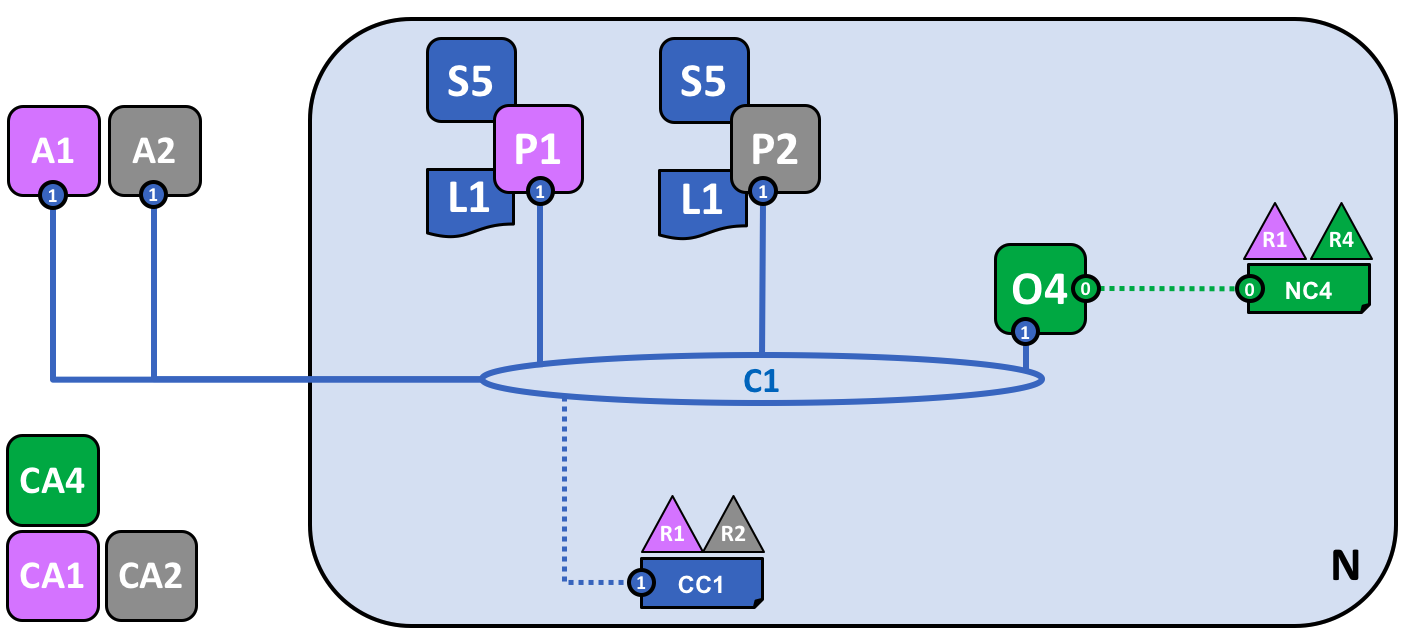 443 444 *The network has grown through the addition of infrastructure from 445 organization R2. Specifically, R2 has added peer node P2, which hosts a copy of 446 ledger L1, and chaincode S5. R2 approves the same chaincode definition as R1. 447 P2 has also joined channel C1, as has application A2. A2 and P2 are identified 448 using certificates from CA2. All of this means that both applications A1 and A2 449 can invoke S5 on C1 either using peer node P1 or P2.* 450 451 We can see that organization R2 has added a peer node, P2, on channel C1. P2 452 also hosts a copy of the ledger L1 and smart contract S5. We can see that R2 has 453 also added client application A2 which can connect to the network via channel 454 C1. To achieve this, an administrator in organization R2 has created peer node 455 P2 and joined it to channel C1, in the same way as an administrator in R1. The 456 administrator also has to approve the same chaincode definition as R1. 457 458 We have created our first operational network! At this stage in network 459 development, we have a channel in which organizations R1 and R2 can fully 460 transact with each other. Specifically, this means that applications A1 and A2 461 can generate transactions using smart contract S5 and ledger L1 on channel C1. 462 463 ### Generating and accepting transactions 464 465 In contrast to peer nodes, which always host a copy of the ledger, we see that 466 there are two different kinds of peer nodes; those which host smart contracts 467 and those which do not. In our network, every peer hosts a copy of the smart 468 contract, but in larger networks, there will be many more peer nodes that do not 469 host a copy of the smart contract. A peer can only *run* a smart contract if it 470 is installed on it, but it can *know* about the interface of a smart contract by 471 being connected to a channel. 472 473 You should not think of peer nodes which do not have smart contracts installed 474 as being somehow inferior. It's more the case that peer nodes with smart 475 contracts have a special power -- to help **generate** transactions. Note that 476 all peer nodes can **validate** and subsequently **accept** or **reject** 477 transactions onto their copy of the ledger L1. However, only peer nodes with a 478 smart contract installed can take part in the process of transaction 479 **endorsement** which is central to the generation of valid transactions. 480 481 We don't need to worry about the exact details of how transactions are 482 generated, distributed and accepted in this topic -- it is sufficient to 483 understand that we have a blockchain network where organizations R1 and R2 can 484 share information and processes as ledger-captured transactions. We'll learn a 485 lot more about transactions, ledgers, smart contracts in other topics. 486 487 ### Types of peers 488 489 In Hyperledger Fabric, while all peers are the same, they can assume multiple 490 roles depending on how the network is configured. We now have enough 491 understanding of a typical network topology to describe these roles. 492 493 * [*Committing peer*](../glossary.html#commitment). Every peer node in a 494 channel is a committing peer. It receives blocks of generated transactions, 495 which are subsequently validated before they are committed to the peer 496 node's copy of the ledger as an append operation. 497 498 * [*Endorsing peer*](../glossary.html#endorsement). Every peer with a smart 499 contract *can* be an endorsing peer if it has a smart contract installed. 500 However, to actually *be* an endorsing peer, the smart contract on the peer 501 must be used by a client application to generate a digitally signed 502 transaction response. The term *endorsing peer* is an explicit reference to 503 this fact. 504 505 An endorsement policy for a smart contract identifies the 506 organizations whose peer should digitally sign a generated transaction 507 before it can be accepted onto a committing peer's copy of the ledger. 508 509 These are the two major types of peer; there are two other roles a peer can 510 adopt: 511 512 * [*Leader peer*](../glossary.html#leading-peer). When an organization has 513 multiple peers in a channel, a leader peer is a node which takes 514 responsibility for distributing transactions from the orderer to the other 515 committing peers in the organization. A peer can choose to participate in 516 static or dynamic leadership selection. 517 518 It is helpful, therefore to think of two sets of peers from leadership 519 perspective -- those that have static leader selection, and those with 520 dynamic leader selection. For the static set, zero or more peers can be 521 configured as leaders. For the dynamic set, one peer will be elected leader 522 by the set. Moreover, in the dynamic set, if a leader peer fails, then the 523 remaining peers will re-elect a leader. 524 525 It means that an organization's peers can have one or more leaders connected 526 to the ordering service. This can help to improve resilience and scalability 527 in large networks which process high volumes of transactions. 528 529 * [*Anchor peer*](../glossary.html#anchor-peer). If a peer needs to 530 communicate with a peer in another organization, then it can use one of the 531 **anchor peers** defined in the channel configuration for that organization. 532 An organization can have zero or more anchor peers defined for it, and an 533 anchor peer can help with many different cross-organization communication 534 scenarios. 535 536 Note that a peer can be a committing peer, endorsing peer, leader peer and 537 anchor peer all at the same time! Only the anchor peer is optional -- for all 538 practical purposes there will always be a leader peer and at least one 539 endorsing peer and at least one committing peer. 540 541 ### Adding organizations and peers to the channel 542 543 When R2 joins the channel, the organization must install smart contract S5 544 onto its peer node, P2. That's obvious -- if applications A1 or A2 wish to use 545 S5 on peer node P2 to generate transactions, it must first be present; 546 installation is the mechanism by which this happens. At this point, peer node P2 547 has a physical copy of the smart contract and the ledger; like P1, it can both 548 generate and accept transactions onto its copy of ledger L1. 549 550 R2 must approve the same chaincode definition as was approved by R1 in order to 551 use smart contract S5. Because the chaincode definition has already been 552 committed to the channel by organization R1, R2 can use the chaincode as soon as 553 the organization approves the chaincode definition and installs the chaincode 554 package. The commit transaction only needs to happen once. A new organization 555 can use the chaincode as soon as they approve the chaincode parameters agreed to 556 by other members of the channel. Because the approval of a chaincode definition 557 occurs at the organization level, R2 can approve the chaincode definition once 558 and join multiple peers to the channel with the chaincode package installed. 559 However, if R2 wanted to change the chaincode definition, both R1 and R2 would 560 need to approve a new definition for their organization, and then one of the 561 organizations would need to commit the definition to the channel. 562 563 In our network, we can see that channel C1 connects two client applications, two 564 peer nodes and an ordering service. Since there is only one channel, there is 565 only one **logical** ledger with which these components interact. Peer nodes P1 566 and P2 have identical copies of ledger L1. Copies of smart contract S5 will 567 usually be identically implemented using the same programming language, but 568 if not, they must be semantically equivalent. 569 570 We can see that the careful addition of peers to the network can help support 571 increased throughput, stability, and resilience. For example, more peers in a 572 network will allow more applications to connect to it; and multiple peers in an 573 organization will provide extra resilience in the case of planned or unplanned 574 outages. 575 576 It all means that it is possible to configure sophisticated topologies which 577 support a variety of operational goals -- there is no theoretical limit to how 578 big a network can get. Moreover, the technical mechanism by which peers within 579 an individual organization efficiently discover and communicate with each other -- 580 the [gossip protocol](../gossip.html#gossip-protocol) -- will accommodate a 581 large number of peer nodes in support of such topologies. 582 583 The careful use of network and channel policies allow even large networks to be 584 well-governed. Organizations are free to add peer nodes to the network so long 585 as they conform to the policies agreed by the network. Network and channel 586 policies create the balance between autonomy and control which characterizes a 587 de-centralized network. 588 589 ## Simplifying the visual vocabulary 590 591 We’re now going to simplify the visual vocabulary used to represent our sample 592 blockchain network. As the size of the network grows, the lines initially used 593 to help us understand channels will become cumbersome. Imagine how complicated 594 our diagram would be if we added another peer or client application, or another 595 channel? 596 597 That's what we're going to do in a minute, so before we do, let's simplify the 598 visual vocabulary. Here's a simplified representation of the network we've 599 developed so far: 600 601  602 603 *The diagram shows the facts relating to channel C1 in the network N as follows: 604 Client applications A1 and A2 can use channel C1 for communication with peers 605 P1 and P2, and orderer O4. Peer nodes P1 and P2 can use the communication 606 services of channel C1. Ordering service O4 can make use of the communication 607 services of channel C1. Channel configuration CC1 applies to channel C1.* 608 609 Note that the network diagram has been simplified by replacing channel lines 610 with connection points, shown as blue circles which include the channel number. 611 No information has been lost. This representation is more scalable because it 612 eliminates crossing lines. This allows us to more clearly represent larger 613 networks. We've achieved this simplification by focusing on the connection 614 points between components and a channel, rather than the channel itself. 615 616 ## Adding another consortium definition 617 618 In this next phase of network development, we introduce organization R3. We're 619 going to give organizations R2 and R3 a separate application channel which 620 allows them to transact with each other. This application channel will be 621 completely separate to that previously defined, so that R2 and R3 transactions 622 can be kept private to them. 623 624 Let's return to the network level and define a new consortium, X2, for R2 and 625 R3: 626 627 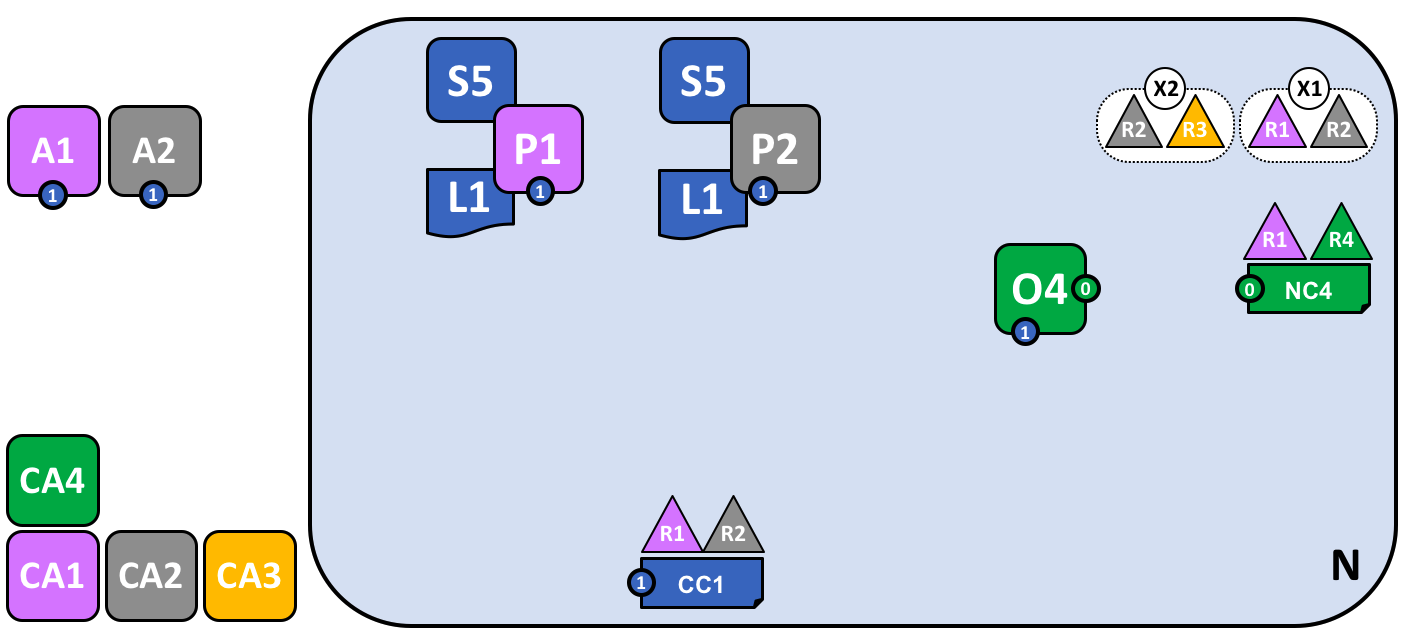 628 629 *A network administrator from organization R1 or R4 has added a new consortium 630 definition, X2, which includes organizations R2 and R3. This will be used to 631 define a new channel for X2.* 632 633 Notice that the network now has two consortia defined: X1 for organizations R1 634 and R2 and X2 for organizations R2 and R3. Consortium X2 has been introduced in 635 order to be able to create a new channel for R2 and R3. 636 637 A new channel can only be created by those organizations specifically identified 638 in the network configuration policy, NC4, as having the appropriate rights to do 639 so, i.e. R1 or R4. This is an example of a policy which separates organizations 640 that can manage resources at the network level versus those who can manage 641 resources at the channel level. Seeing these policies at work helps us 642 understand why Hyperledger Fabric has a sophisticated **tiered** policy 643 structure. 644 645 In practice, consortium definition X2 has been added to the network 646 configuration NC4. We discuss the exact mechanics of this operation elsewhere in 647 the documentation. 648 649 ## Adding a new channel 650 651 Let's now use this new consortium definition, X2, to create a new channel, C2. 652 To help reinforce your understanding of the simpler channel notation, we've used 653 both visual styles -- channel C1 is represented with blue circular end points, 654 whereas channel C2 is represented with red connecting lines: 655 656 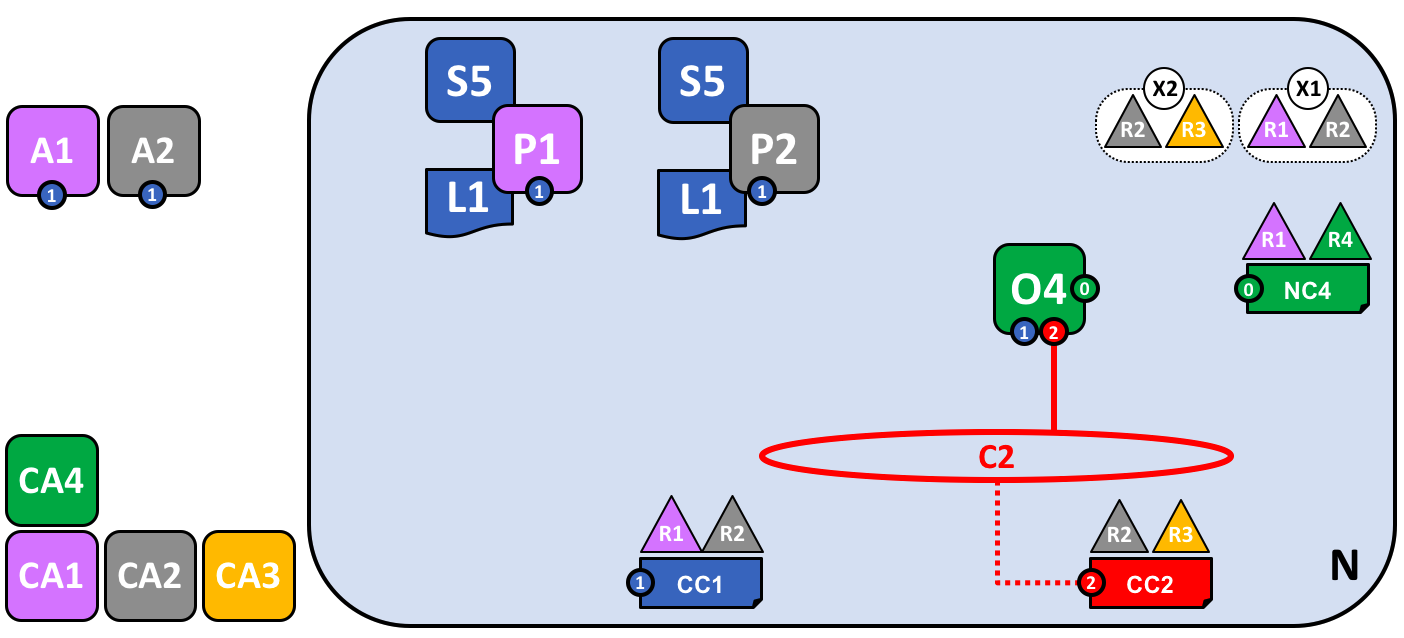 657 658 *A new channel C2 has been created for R2 and R3 using consortium definition X2. 659 The channel has a channel configuration CC2, completely separate to the network 660 configuration NC4, and the channel configuration CC1. Channel C2 is managed by 661 R2 and R3 who have equal rights over C2 as defined by a policy in CC2. R1 and 662 R4 have no rights defined in CC2 whatsoever.* 663 664 The channel C2 provides a private communications mechanism for the consortium 665 X2. Again, notice how organizations united in a consortium are what form 666 channels. The channel configuration CC2 now contains the policies that govern 667 channel resources, assigning management rights to organizations R2 and R3 over 668 channel C2. It is managed exclusively by R2 and R3; R1 and R4 have no power in 669 channel C2. For example, channel configuration CC2 can subsequently be updated 670 to add organizations to support network growth, but this can only be done by R2 671 or R3. 672 673 Note how the channel configurations CC1 and CC2 remain completely separate from 674 each other, and completely separate from the network configuration, NC4. Again 675 we're seeing the de-centralized nature of a Hyperledger Fabric network; once 676 channel C2 has been created, it is managed by organizations R2 and R3 677 independently to other network elements. Channel policies always remain separate 678 from each other and can only be changed by the organizations authorized to do so 679 in the channel. 680 681 As the network and channels evolve, so will the network and channel 682 configurations. There is a process by which this is accomplished in a controlled 683 manner -- involving configuration transactions which capture the change to these 684 configurations. Every configuration change results in a new configuration block 685 transaction being generated, and [later in this topic](#the-ordering-serivce), 686 we'll see how these blocks are validated and accepted to create updated network 687 and channel configurations respectively. 688 689 ### Network and channel configurations 690 691 Throughout our sample network, we see the importance of network and channel 692 configurations. These configurations are important because they encapsulate the 693 **policies** agreed by the network members, which provide a shared reference for 694 controlling access to network resources. Network and channel configurations also 695 contain **facts** about the network and channel composition, such as the name of 696 consortia and its organizations. 697 698 For example, when the network is first formed using the ordering service node 699 O4, its behaviour is governed by the network configuration NC4. The initial 700 configuration of NC4 only contains policies that permit organization R4 to 701 manage network resources. NC4 is subsequently updated to also allow R1 to manage 702 network resources. Once this change is made, any administrator from organization 703 R1 or R4 that connects to O4 will have network management rights because that is 704 what the policy in the network configuration NC4 permits. Internally, each node 705 in the ordering service records each channel in the network configuration, so 706 that there is a record of each channel created, at the network level. 707 708 It means that although ordering service node O4 is the actor that created 709 consortia X1 and X2 and channels C1 and C2, the **intelligence** of the network 710 is contained in the network configuration NC4 that O4 is obeying. As long as O4 711 behaves as a good actor, and correctly implements the policies defined in NC4 712 whenever it is dealing with network resources, our network will behave as all 713 organizations have agreed. In many ways NC4 can be considered more important 714 than O4 because, ultimately, it controls network access. 715 716 The same principles apply for channel configurations with respect to peers. In 717 our network, P1 and P2 are likewise good actors. When peer nodes P1 and P2 are 718 interacting with client applications A1 or A2 they are each using the policies 719 defined within channel configuration CC1 to control access to the channel C1 720 resources. 721 722 For example, if A1 wants to access the smart contract chaincode S5 on peer nodes 723 P1 or P2, each peer node uses its copy of CC1 to determine the operations that 724 A1 can perform. For example, A1 may be permitted to read or write data from the 725 ledger L1 according to policies defined in CC1. We'll see later the same pattern 726 for actors in channel and its channel configuration CC2. Again, we can see that 727 while the peers and applications are critical actors in the network, their 728 behaviour in a channel is dictated more by the channel configuration policy than 729 any other factor. 730 731 Finally, it is helpful to understand how network and channel configurations are 732 physically realized. We can see that network and channel configurations are 733 logically singular -- there is one for the network, and one for each channel. 734 This is important; every component that accesses the network or the channel must 735 have a shared understanding of the permissions granted to different 736 organizations. 737 738 Even though there is logically a single configuration, it is actually replicated 739 and kept consistent by every node that forms the network or channel. For 740 example, in our network peer nodes P1 and P2 both have a copy of channel 741 configuration CC1, and by the time the network is fully complete, peer nodes P2 742 and P3 will both have a copy of channel configuration CC2. Similarly ordering 743 service node O4 has a copy of the network configuration, but in a [multi-node 744 configuration](#the-ordering-service), every ordering service node will have its 745 own copy of the network configuration. 746 747 Both network and channel configurations are kept consistent using the same 748 blockchain technology that is used for user transactions -- but for 749 **configuration** transactions. To change a network or channel configuration, an 750 administrator must submit a configuration transaction to change the network or 751 channel configuration. It must be signed by the organizations identified in the 752 appropriate policy as being responsible for configuration change. This policy is 753 called the **mod_policy** and we'll [discuss it later](#changing-policy). 754 755 Indeed, the ordering service nodes operate a mini-blockchain, connected via the 756 **system channel** we mentioned earlier. Using the system channel ordering 757 service nodes distribute network configuration transactions. These transactions 758 are used to co-operatively maintain a consistent copy of the network 759 configuration at each ordering service node. In a similar way, peer nodes in an 760 **application channel** can distribute channel configuration transactions. 761 Likewise, these transactions are used to maintain a consistent copy of the 762 channel configuration at each peer node. 763 764 This balance between objects that are logically singular, by being physically 765 distributed is a common pattern in Hyperledger Fabric. Objects like network 766 configurations, that are logically single, turn out to be physically replicated 767 among a set of ordering services nodes for example. We also see it with channel 768 configurations, ledgers, and to some extent smart contracts which are installed 769 in multiple places but whose interfaces exist logically at the channel level. 770 It's a pattern you see repeated time and again in Hyperledger Fabric, and 771 enables Hyperledger Fabric to be both de-centralized and yet manageable at the 772 same time. 773 774 ## Adding another peer 775 776 Now that organization R3 is able to fully participate in channel C2, let's add 777 its infrastructure components to the channel. Rather than do this one component 778 at a time, we're going to add a peer, its local copy of a ledger, a smart 779 contract and a client application all at once! 780 781 Let's see the network with organization R3's components added: 782 783 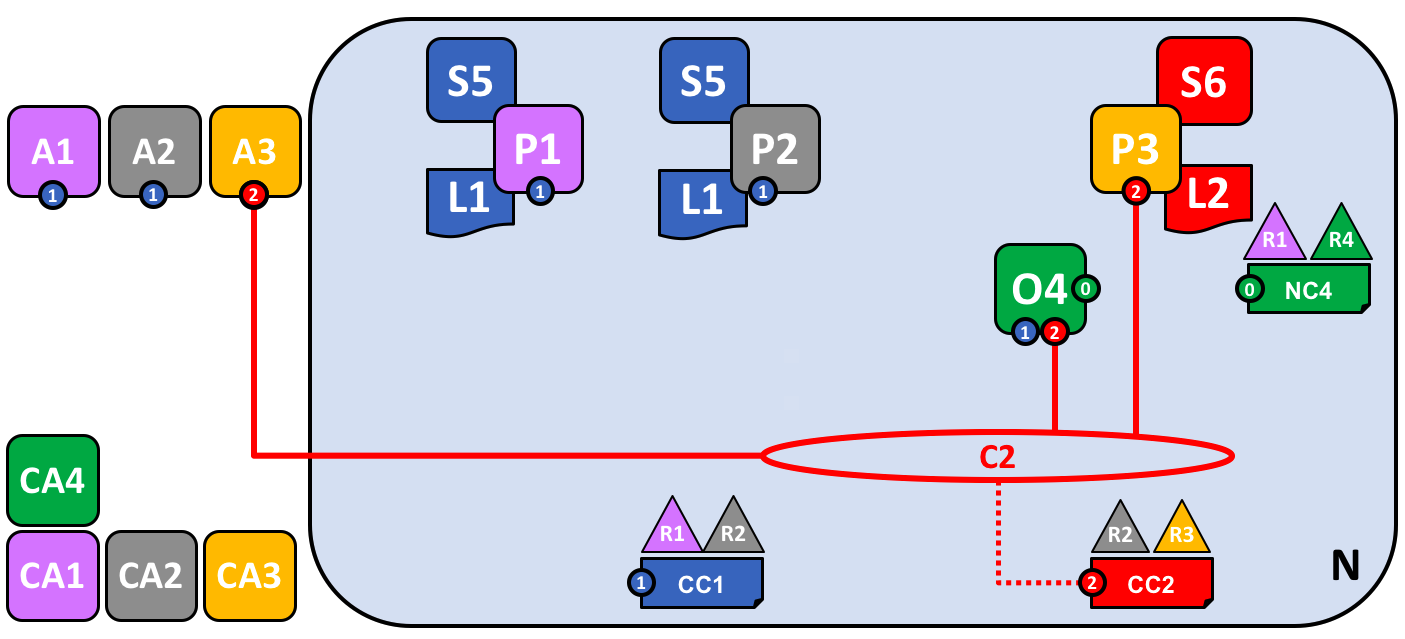 784 785 *The diagram shows the facts relating to channels C1 and C2 in the network N as 786 follows: Client applications A1 and A2 can use channel C1 for communication 787 with peers P1 and P2, and ordering service O4; client applications A3 can use 788 channel C2 for communication with peer P3 and ordering service O4. Ordering 789 service O4 can make use of the communication services of channels C1 and C2. 790 Channel configuration CC1 applies to channel C1, CC2 applies to channel C2.* 791 792 First of all, notice that because peer node P3 is connected to channel C2, it 793 has a **different** ledger -- L2 -- to those peer nodes using channel C1. The 794 ledger L2 is effectively scoped to channel C2. The ledger L1 is completely 795 separate; it is scoped to channel C1. This makes sense -- the purpose of the 796 channel C2 is to provide private communications between the members of the 797 consortium X2, and the ledger L2 is the private store for their transactions. 798 799 In a similar way, the smart contract S6, installed on peer node P3, and defined 800 on channel C2, is used to provide controlled access to ledger L2. Application A3 801 can now use channel C2 to invoke the services provided by smart contract S6 to 802 generate transactions that can be accepted onto every copy of the ledger L2 in 803 the network. 804 805 At this point in time, we have a single network that has two completely separate 806 channels defined within it. These channels provide independently managed 807 facilities for organizations to transact with each other. Again, this is 808 de-centralization at work; we have a balance between control and autonomy. This 809 is achieved through policies which are applied to channels which are controlled 810 by, and affect, different organizations. 811 812 ## Joining a peer to multiple channels 813 814 In this final stage of network development, let's return our focus to 815 organization R2. We can exploit the fact that R2 is a member of both consortia 816 X1 and X2 by joining it to multiple channels: 817 818 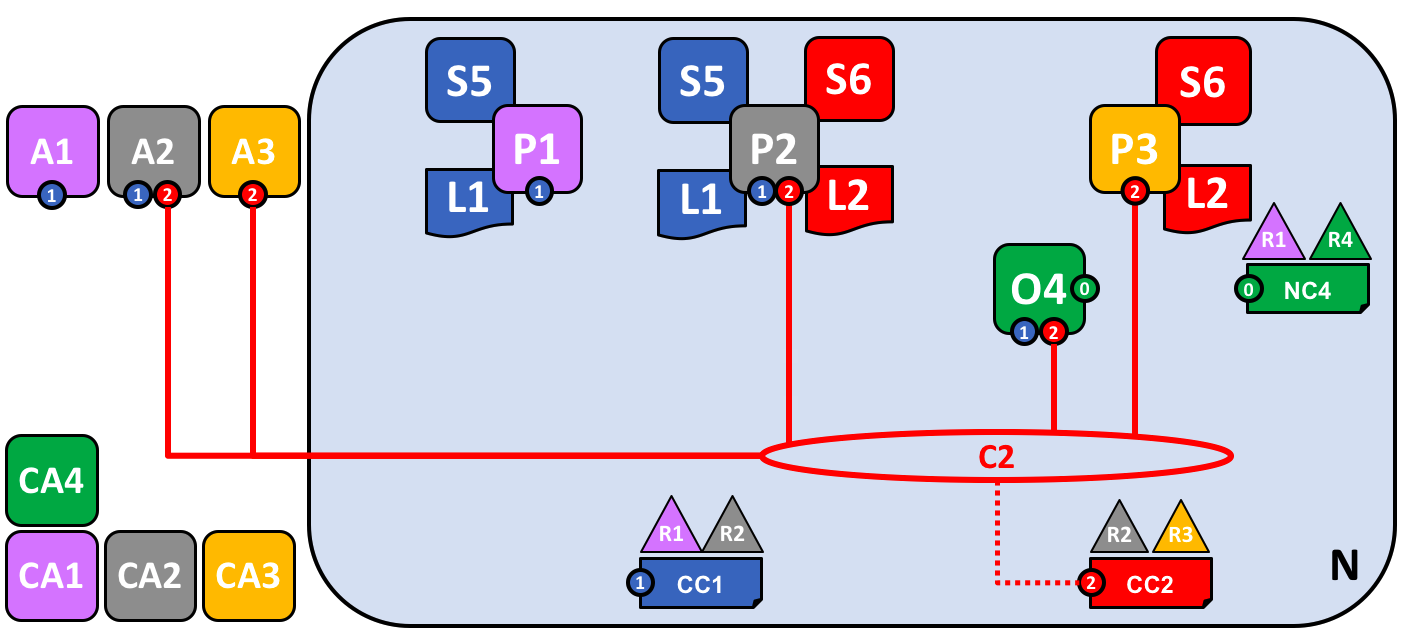 819 820 *The diagram shows the facts relating to channels C1 and C2 in the network N as 821 follows: Client applications A1 can use channel C1 for communication with peers 822 P1 and P2, and ordering service O4; client application A2 can use channel C1 823 for communication with peers P1 and P2 and channel C2 for communication with 824 peers P2 and P3 and ordering service O4; client application A3 can use channel 825 C2 for communication with peer P3 and P2 and ordering service O4. Ordering service O4 826 can make use of the communication services of channels C1 and C2. Channel 827 configuration CC1 applies to channel C1, CC2 applies to channel C2.* 828 829 We can see that R2 is a special organization in the network, because it is the 830 only organization that is a member of two application channels! It is able to 831 transact with organization R1 on channel C1, while at the same time it can also 832 transact with organization R3 on a different channel, C2. 833 834 Notice how peer node P2 has smart contract S5 installed for channel C1 and smart 835 contract S6 installed for channel C2. Peer node P2 is a full member of both 836 channels at the same time via different smart contracts for different ledgers. 837 838 This is a very powerful concept -- channels provide both a mechanism for the 839 separation of organizations, and a mechanism for collaboration between 840 organizations. All the while, this infrastructure is provided by, and shared 841 between, a set of independent organizations. 842 843 It is also important to note that peer node P2's behaviour is controlled very 844 differently depending upon the channel in which it is transacting. Specifically, 845 the policies contained in channel configuration CC1 dictate the operations 846 available to P2 when it is transacting in channel C1, whereas it is the policies 847 in channel configuration CC2 that control P2's behaviour in channel C2. 848 849 Again, this is desirable -- R2 and R1 agreed the rules for channel C1, whereas 850 R2 and R3 agreed the rules for channel C2. These rules were captured in the 851 respective channel policies -- they can and must be used by every 852 component in a channel to enforce correct behaviour, as agreed. 853 854 Similarly, we can see that client application A2 is now able to transact on 855 channels C1 and C2. And likewise, it too will be governed by the policies in 856 the appropriate channel configurations. As an aside, note that client 857 application A2 and peer node P2 are using a mixed visual vocabulary -- both 858 lines and connections. You can see that they are equivalent; they are visual 859 synonyms. 860 861 ### The ordering service 862 863 The observant reader may notice that the ordering service node appears to be a 864 centralized component; it was used to create the network initially, and connects 865 to every channel in the network. Even though we added R1 and R4 to the network 866 configuration policy NC4 which controls the orderer, the node was running on 867 R4's infrastructure. In a world of de-centralization, this looks wrong! 868 869 Don't worry! Our example network showed the simplest ordering service 870 configuration to help you understand the idea of a network administration point. 871 In fact, the ordering service can itself too be completely de-centralized! We 872 mentioned earlier that an ordering service could be comprised of many individual 873 nodes owned by different organizations, so let's see how that would be done in 874 our sample network. 875 876 Let's have a look at a more realistic ordering service node configuration: 877 878 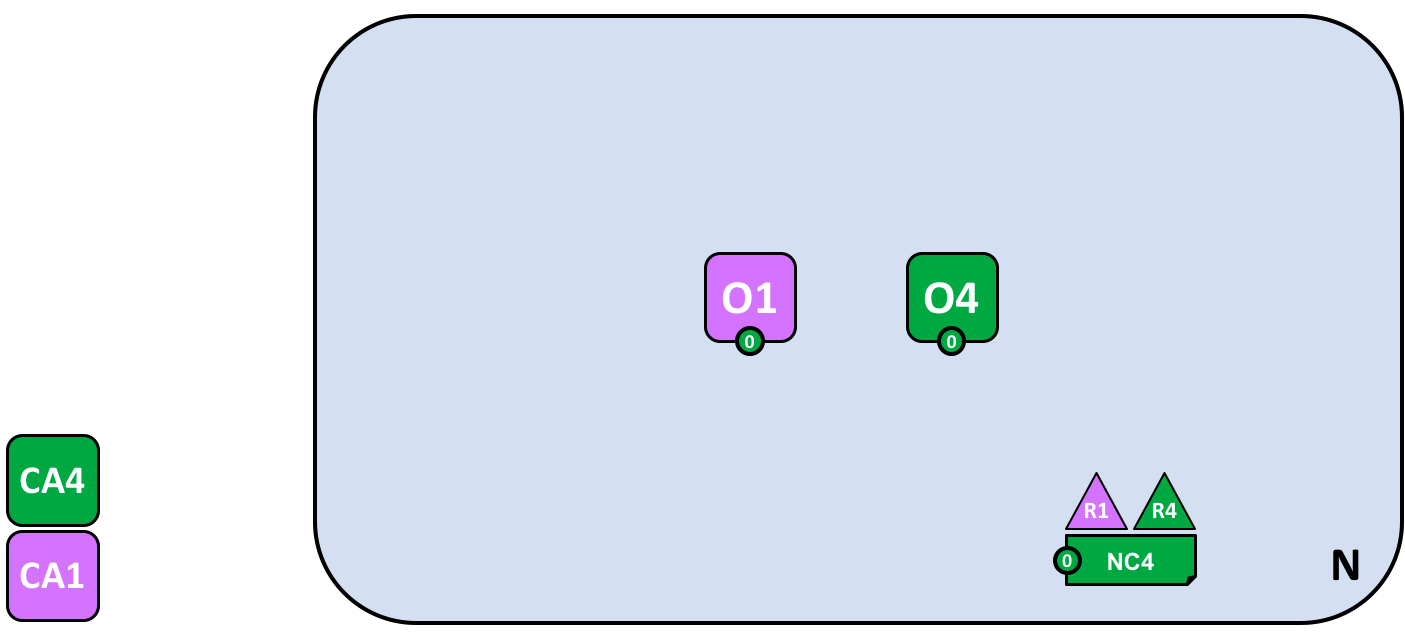 879 880 *A multi-organization ordering service. The ordering service comprises ordering 881 service nodes O1 and O4. O1 is provided by organization R1 and node O4 is 882 provided by organization R4. The network configuration NC4 defines network 883 resource permissions for actors from both organizations R1 and R4.* 884 885 We can see that this ordering service completely de-centralized -- it runs in 886 organization R1 and it runs in organization R4. The network configuration 887 policy, NC4, permits R1 and R4 equal rights over network resources. Client 888 applications and peer nodes from organizations R1 and R4 can manage network 889 resources by connecting to either node O1 or node O4, because both nodes behave 890 the same way, as defined by the policies in network configuration NC4. In 891 practice, actors from a particular organization *tend* to use infrastructure 892 provided by their home organization, but that's certainly not always the case. 893 894 ### De-centralized transaction distribution 895 896 As well as being the management point for the network, the ordering service also 897 provides another key facility -- it is the distribution point for transactions. 898 The ordering service is the component which gathers endorsed transactions 899 from applications and orders them into transaction blocks, which are 900 subsequently distributed to every peer node in the channel. At each of these 901 committing peers, transactions are recorded, whether valid or invalid, and their 902 local copy of the ledger updated appropriately. 903 904 Notice how the ordering service node O4 performs a very different role for the 905 channel C1 than it does for the network N. When acting at the channel level, 906 O4's role is to gather transactions and distribute blocks inside channel C1. It 907 does this according to the policies defined in channel configuration CC1. In 908 contrast, when acting at the network level, O4's role is to provide a management 909 point for network resources according to the policies defined in network 910 configuration NC4. Notice again how these roles are defined by different 911 policies within the channel and network configurations respectively. This should 912 reinforce to you the importance of declarative policy based configuration in 913 Hyperledger Fabric. Policies both define, and are used to control, the agreed 914 behaviours by each and every member of a consortium. 915 916 We can see that the ordering service, like the other components in Hyperledger 917 Fabric, is a fully de-centralized component. Whether acting as a network 918 management point, or as a distributor of blocks in a channel, its nodes can be 919 distributed as required throughout the multiple organizations in a network. 920 921 ### Changing policy 922 923 Throughout our exploration of the sample network, we've seen the importance of 924 the policies to control the behaviour of the actors in the system. We've only 925 discussed a few of the available policies, but there are many that can be 926 declaratively defined to control every aspect of behaviour. These individual 927 policies are discussed elsewhere in the documentation. 928 929 Most importantly of all, Hyperledger Fabric provides a uniquely powerful policy 930 that allows network and channel administrators to manage policy change itself! 931 The underlying philosophy is that policy change is a constant, whether it occurs 932 within or between organizations, or whether it is imposed by external 933 regulators. For example, new organizations may join a channel, or existing 934 organizations may have their permissions increased or decreased. Let's 935 investigate a little more how change policy is implemented in Hyperledger 936 Fabric. 937 938 They key point of understanding is that policy change is managed by a 939 policy within the policy itself. The **modification policy**, or 940 **mod_policy** for short, is a first class policy within a network or channel 941 configuration that manages change. Let's give two brief examples of how we've 942 **already** used mod_policy to manage change in our network! 943 944 The first example was when the network was initially set up. At this time, only 945 organization R4 was allowed to manage the network. In practice, this was 946 achieved by making R4 the only organization defined in the network configuration 947 NC4 with permissions to network resources. Moreover, the mod_policy for NC4 948 only mentioned organization R4 -- only R4 was allowed to change this 949 configuration. 950 951 We then evolved the network N to also allow organization R1 to administer the 952 network. R4 did this by adding R1 to the policies for channel creation and 953 consortium creation. Because of this change, R1 was able to define the 954 consortia X1 and X2, and create the channels C1 and C2. R1 had equal 955 administrative rights over the channel and consortium policies in the network 956 configuration. 957 958 R4 however, could grant even more power over the network configuration to R1! R4 959 could add R1 to the mod_policy such that R1 would be able to manage change of 960 the network policy too. 961 962 This second power is much more powerful than the first, because R1 now has 963 **full control** over the network configuration NC4! This means that R1 can, in 964 principle remove R4's management rights from the network. In practice, R4 would 965 configure the mod_policy such that R4 would need to also approve the change, or 966 that all organizations in the mod_policy would have to approve the change. 967 There's lots of flexibility to make the mod_policy as sophisticated as it needs 968 to be to support whatever change process is required. 969 970 This is mod_policy at work -- it has allowed the graceful evolution of a basic 971 configuration into a sophisticated one. All the time this has occurred with the 972 agreement of all organization involved. The mod_policy behaves like every other 973 policy inside a network or channel configuration; it defines a set of 974 organizations that are allowed to change the mod_policy itself. 975 976 We've only scratched the surface of the power of policies and mod_policy in 977 particular in this subsection. It is discussed at much more length in the policy 978 topic, but for now let's return to our finished network! 979 980 ## Network fully formed 981 982 Let's recap what our network looks like using a consistent visual vocabulary. 983 We've re-organized it slightly using our more compact visual syntax, because it 984 better accommodates larger topologies: 985 986 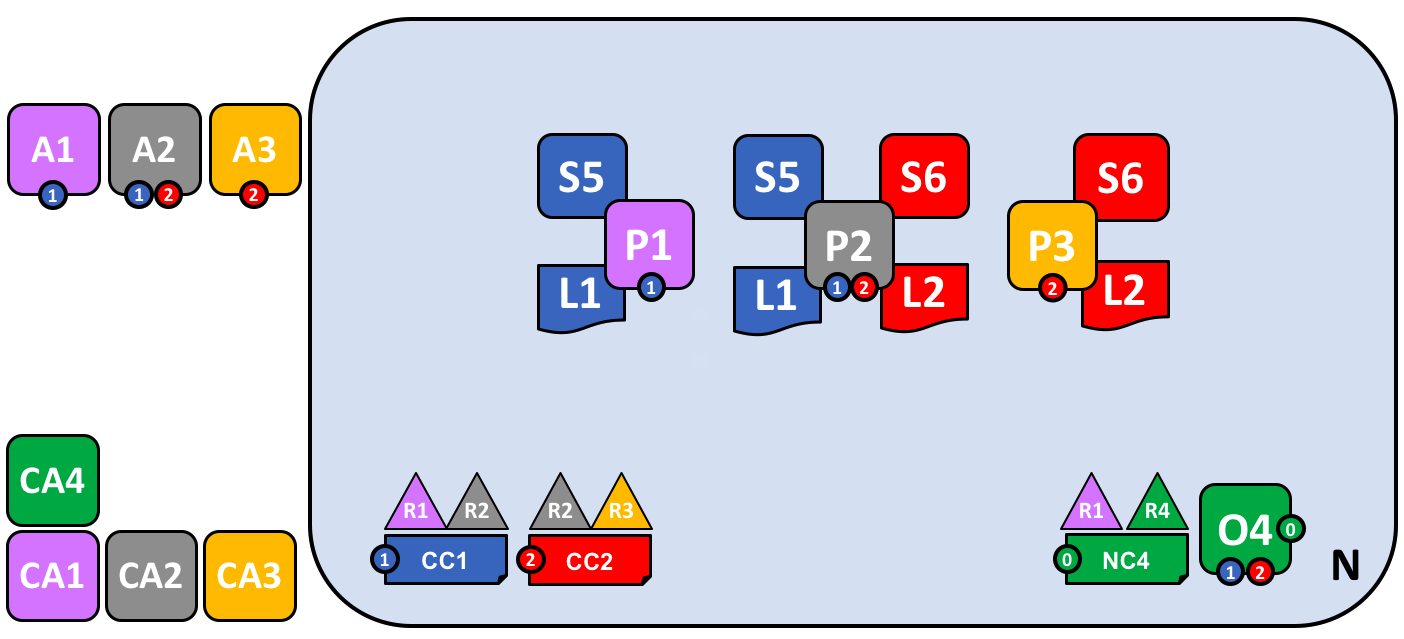 987 988 *In this diagram we see that the Fabric blockchain network consists of two 989 application channels and one ordering channel. The organizations R1 and R4 are 990 responsible for the ordering channel, R1 and R2 are responsible for the blue 991 application channel while R2 and R3 are responsible for the red application 992 channel. Client applications A1 is an element of organization R1, and CA1 is 993 it's certificate authority. Note that peer P2 of organization R2 can use the 994 communication facilities of the blue and the red application channel. Each 995 application channel has its own channel configuration, in this case CC1 and 996 CC2. The channel configuration of the system channel is part of the network 997 configuration, NC4.* 998 999 We're at the end of our conceptual journey to build a sample Hyperledger Fabric 1000 blockchain network. We've created a four organization network with two channels 1001 and three peer nodes, with two smart contracts and an ordering service. It is 1002 supported by four certificate authorities. It provides ledger and smart contract 1003 services to three client applications, who can interact with it via the two 1004 channels. Take a moment to look through the details of the network in the 1005 diagram, and feel free to read back through the topic to reinforce your 1006 knowledge, or go to a more detailed topic. 1007 1008 ### Summary of network components 1009 1010 Here's a quick summary of the network components we've discussed: 1011 1012 * [Ledger](../glossary.html#ledger). One per channel. Comprised of the 1013 [Blockchain](../glossary.html#block) and 1014 the [World state](../glossary.html#world-state) 1015 * [Smart contract](../glossary.html#smart-contract) (aka chaincode) 1016 * [Peer nodes](../glossary.html#peer) 1017 * [Ordering service](../glossary.html#ordering-service) 1018 * [Channel](../glossary.html#channel) 1019 * [Certificate Authority](../glossary.html#hyperledger-fabric-ca) 1020 1021 ## Network summary 1022 1023 In this topic, we've seen how different organizations share their infrastructure 1024 to provide an integrated Hyperledger Fabric blockchain network. We've seen how 1025 the collective infrastructure can be organized into channels that provide 1026 private communications mechanisms that are independently managed. We've seen 1027 how actors such as client applications, administrators, peers and orderers are 1028 identified as being from different organizations by their use of certificates 1029 from their respective certificate authorities. And in turn, we've seen the 1030 importance of policy to define the agreed permissions that these organizational 1031 actors have over network and channel resources.